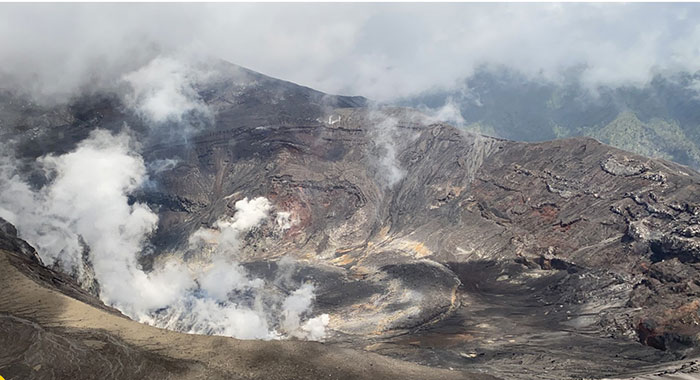Some areas of La Soufriere are expected to remain extremely hot for a long time, but will only pose a risk to persons at or close to the summit of the volcano.
The low level of activity at the volcano since the last explosion on April 22 is expected to continue for over the next weeks and months.
Eroucilla Joseph, director of the UWI Seismic Research Centre, and current head of the monitoring team in St. Vincent, gave this outlook in the regular update on NBC Radio on Wednesday.
“It’s been the same and this is a pattern that will continue for weeks to months of continuing low level of seismic activity until we go back to what we consider to be background seismicity for La Soufriere,” Joseph said as she updated the nation on activities at the volcano in the preceding 48 hours.
She said that the monitoring network had observed no deformation of the volcano.
“We continue to see a consistent amount of degassing with an average flux of about 502 tonnes per day.”
She, however, said that a measurement was done on July 8 on the west coast of St. Vincent and this yielded a flux of 306 tonnes.
Another measurement was done on Tuesday, but the results have not been processed as yet.”
Joseph said there were no thermal anomalies in the crater at present that were of concern to residents of communities near to the volcano.
“It’s of concern to those who are working on the volcano, especially around the summit because it means that there is very hot material still there that’s cooling and that hot material would, of course, be remnants of the magma that would have been extruded in the explosive eruption. So what’s sitting there is the remaining hot material that will slowly cool over time.
“Now, remember these are thousands of degrees Celsius. So the fumarole there will be extremely hot and this will continue to be observed a long time as well as it slowly cools and degasses.”
She said that the primary concern, therefore, is if there is rainfall or even normal water percolation while essential workers are at the summit.
“… as we all know, there is a small lake in the crater as well that signifies that there is storage of water in the volcano itself.”
She said the rocks are so hot that when water touches them it immediately vaporises.
“So it goes instantly from the aqueous or water phase to a gas phase and that is often accompanied by a release of energy and these things generate little explosions, which we call phreatic explosion in the crater. So this is limited to that area and it is mostly a hazard to anybody on the flanks of the volcano, particularly at the summit.”
Joseph said that the thermal anomalies are seen by satellite, which is how the extrusion was detected on Dec. 27.
“It just means that the temperatures are above normal — a lot above normal.”
She said that the thermal anomalies will cool over time.
“… and if there is no fresh influx of magma, then the concern is just preparing ourselves to understand that this thermal anomy will be seen until it cools sufficiently.”
The scientist said there are now six stations streaming information into the research centre in Trinidad.
And while the monitoring station at the summit is still not fully online, there are additional stations such as the one in Fitz Hughes and the one in Greiggs.
Hurricane Elsa, on July 2, affected the fibre network through which the seismic and GPS network is connected and the team had lost communication to Trinidad from a number of stations.
That has been resolved and there are six stations, including the new one at Fitz Hughes.
There is a station at Fancy, where they have to go in physically and download the data to process it.
Meanwhile, Prime Minister Ralph Gonsalves, who was also a guest on the programme, said that while the seismic activity is at a low level, “we cannot drop our guard”.
The alert level remains at Orange, the third highest on the four-level scale,
Before arriving in St. Vincent to take over as head of the monitoring team, Joseph had advised the government to drop the alert level to yellow – level two.






